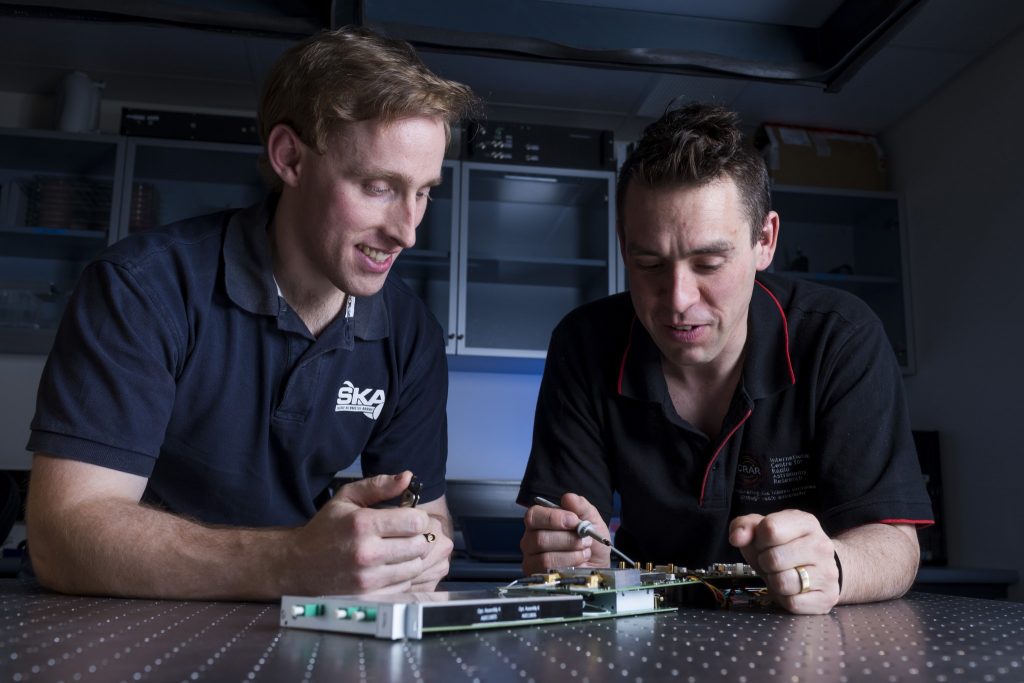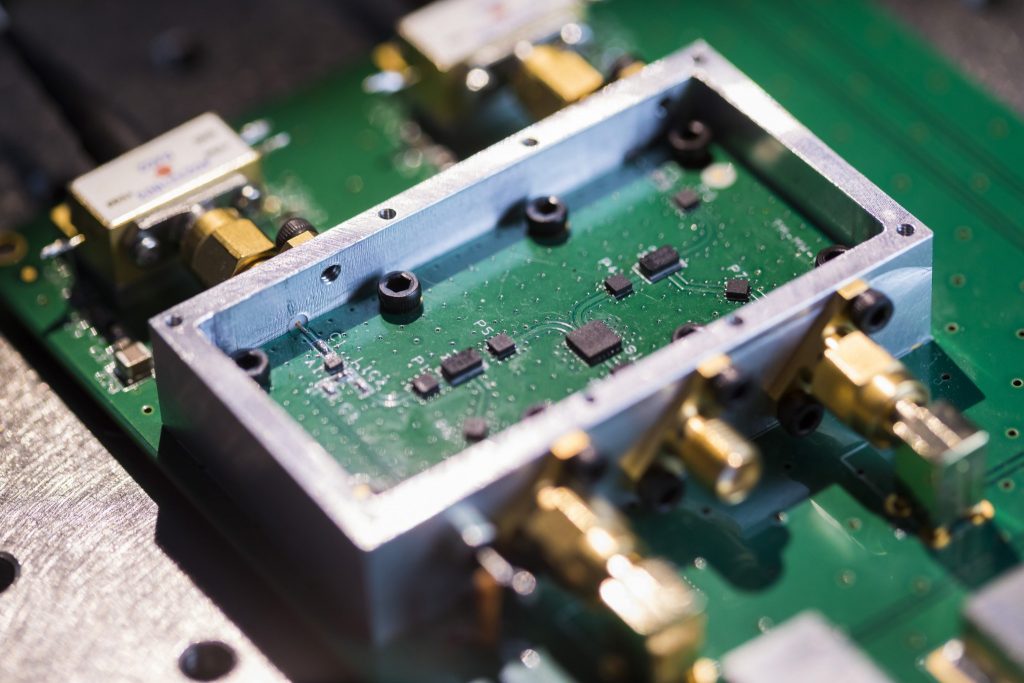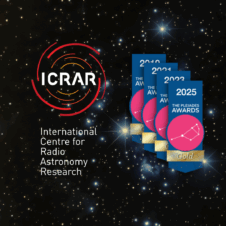An optical fibre-based synchronisation system designed by an Australian team from the International Centre for Radio Astronomy Research (ICRAR) has been selected for SKA-mid in South Africa, with a system designed by Tsinghua University chosen for SKA-low.
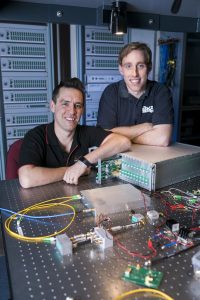
Sascha Schediwy and David Gozzard with an SKA-mid Transmitter Module and Sub-Rack enclosure. Credit: ICRAR.
While optical fibres are incredibly stable and suited to transport data, mechanical stresses and thermal changes do affect the fibre, degrading the stability of the transmitted signals over long distances.
The long distances between SKA antennas will mean radio waves from the sky reach each antenna at different times. With thousands of antennas to be spread over continental scales and therefore thousands of kilometres of fibre, one of the most complex technical challenges for the SKA is to synchronise the incoming signals with extreme precision before they’re combined by the SKA’s supercomputers.
“Given the scale of the SKA, this is an engineering problem that hadn’t really been faced before by any astronomical observatory and we need to achieve a precision better than five parts in a trillion” said André Van Es, the SaDT Engineering Project Manager supervising the consortium’s work for SKA Organisation.
To achieve this level of precision or “coherence” across the array, the SKA requires a synchronisation distribution system that supresses these fibre fluctuations in real time.
“The performance required is less than 2% coherence loss. Bearing in mind a 1% loss is equivalent to losing 2 dishes or antenna stations, it’s crucial that we get this right for the telescopes to be effective,” explained SKAO timing domain specialist Rodrigo Olguin.
The reference signals sent by the synchronisation distribution system travel to each antenna using the optical fibre network also used for transporting astronomical data to the SKA’s central computer. The system then takes into account the mechanical stresses and thermal changes in the fibre and corrects the timing difference to make sure all signals coming from the antennas are digitised synchronously with a precision better than five parts in a trillion.
An optical fibre-based synchronisation distribution system designed by a team from the International Centre for Radio Astronomy Research (ICRAR) in Perth was selected for SKA dishes in South Africa, and a system designed by Tsinghua University in Beijing for SKA antennas in Australia.

A Sub-Rack enclosure used to hold 16 of the 197 Transmitter Modules for the SKA-mid phase synchronisation system. One prototype Transmitter Module is shown partly extended from the front of the enclosure, revealing details of the system’s critical fibre-optic components. Credit: ICRAR.
“Our SKA frequency synchronisation system continuously measures changes in the fibre link and applies corrections in real-time with fluctuations of no more than five parts in one-hundred trillion over a 1-second period”, said lead designer, Dr Sascha Schediwy from ICRAR and The University of Western Australia (UWA).
The system has been extensively tested in a laboratory setting with signals transmitted over metropolitan fibre links and fibre spools. In the field, the system has been tested on 186 km of overhead fibre at the South African SKA-mid telescope site, and astronomical verification conducted with the Australia Telescope Compact Array.
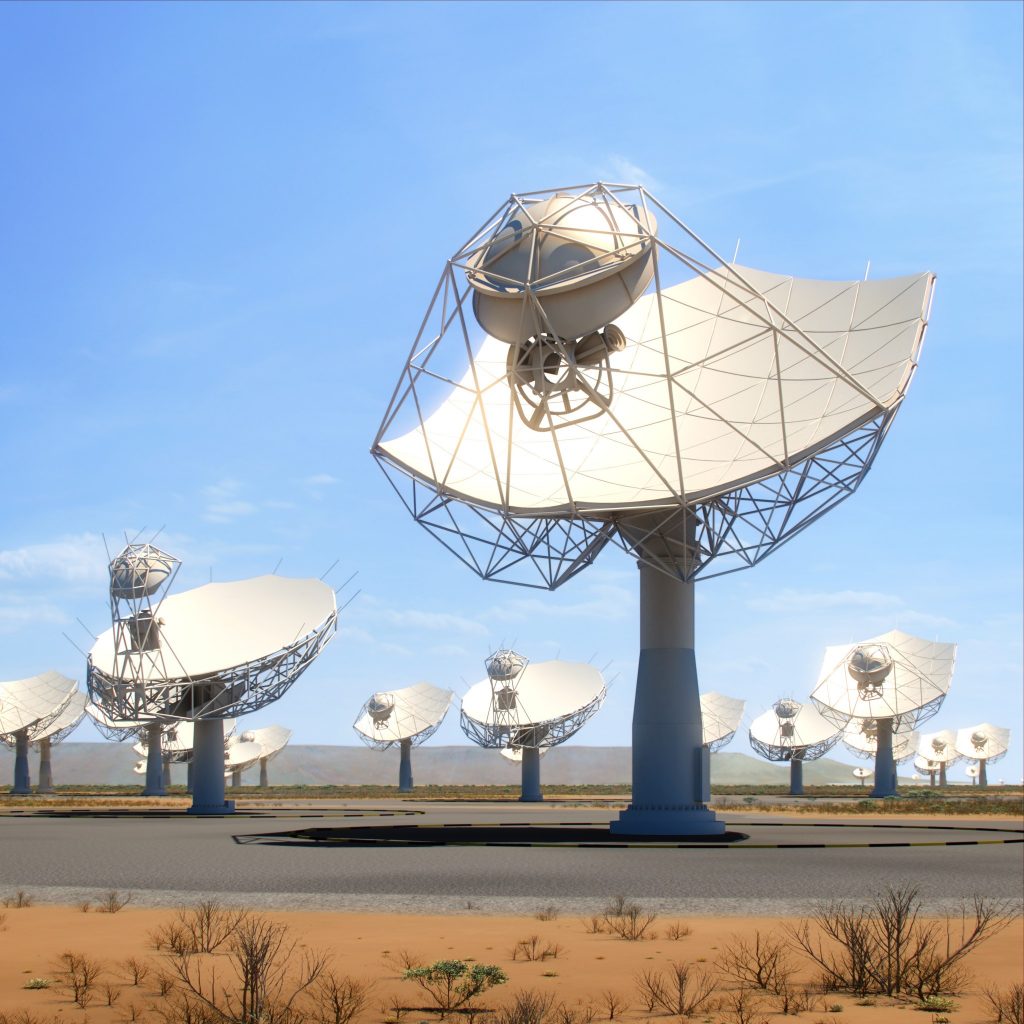
This artists rendition of the SKA-mid dishes in Africa shows how they may eventually look when completed. The 15m wide dish telescopes will provide the SKA with some of its highest resolution imaging capability, working towards the upper range of radio frequencies which the SKA will cover. Credit: SKA Organisation.
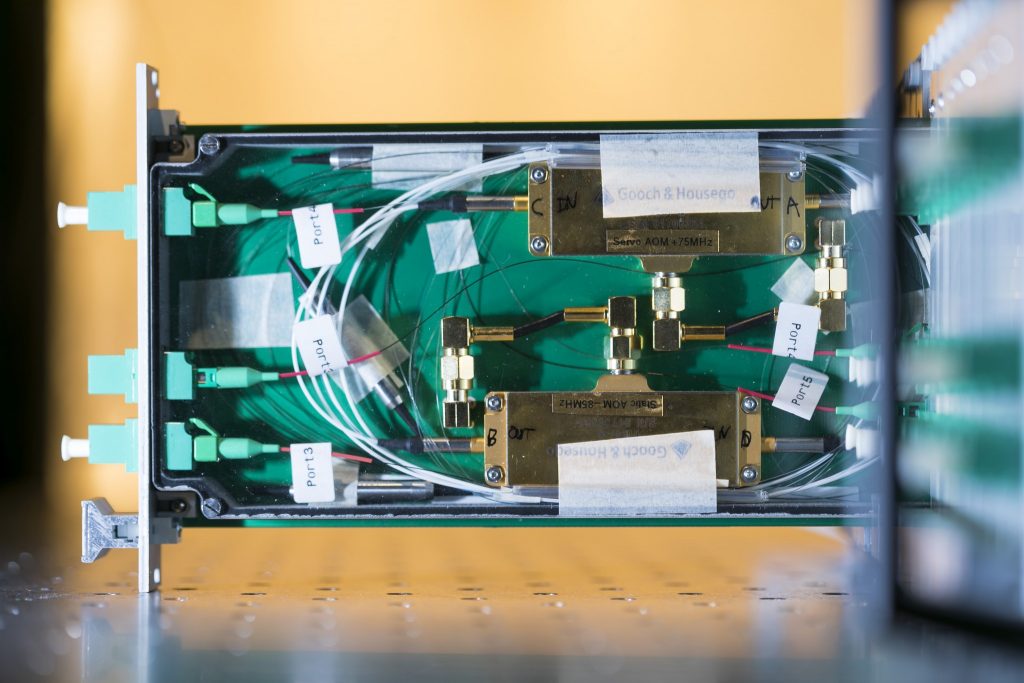
A prototype Transmitter Module shown partly extended from the front of a Sub-Rack enclosure, revealing details of the system’s critical fibre-optic components. Credit: ICRAR.
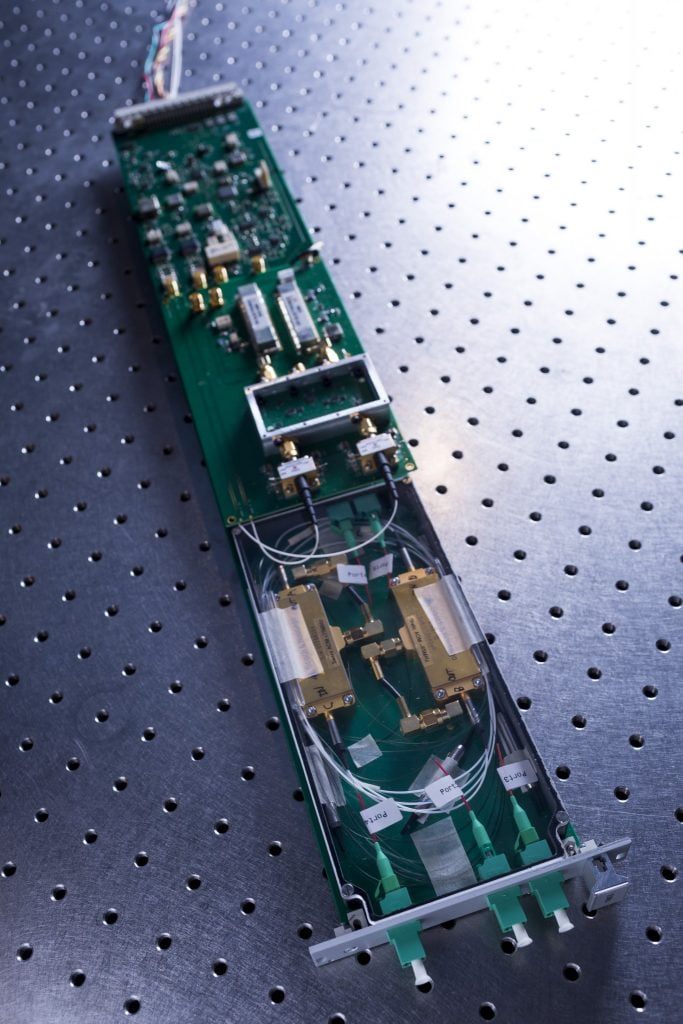
A prototype Transmitter Module showing the fibre-optic components in the foreground, the electronic microwave-frequency mixing circuitry in the middle, and stabilisation electronics at the rear. The SKA-mid synchronisation system will comprise 197 of these modules. Credit: ICRAR.
“A clock relying on a signal of that stability would only gain or lose a second after 600,000 years and field tests have shown our system to be performing between 100 and 10,000 times better than what’s required for the SKA,” said Dr Schediwy.
“Working with the SKA-mid telescope is an enormous technological challenge, with the higher frequency of the transmitted signals requiring extreme levels of stabilisation precision,” he said.
“The system needs to be deployed on 197 independent fibre links with distances up to 175 km—the longest of which will be mounted on overhead poles. This means that the noise caused by the environment is a thousand times that of a buried fibre.”
The Chinese system selected for the Australian-based SKA telescope, namely SKA-low, is required to deliver a 10 MHz signal to 36 remote antenna stations with a maximum distance of 60 km of buried fibre.
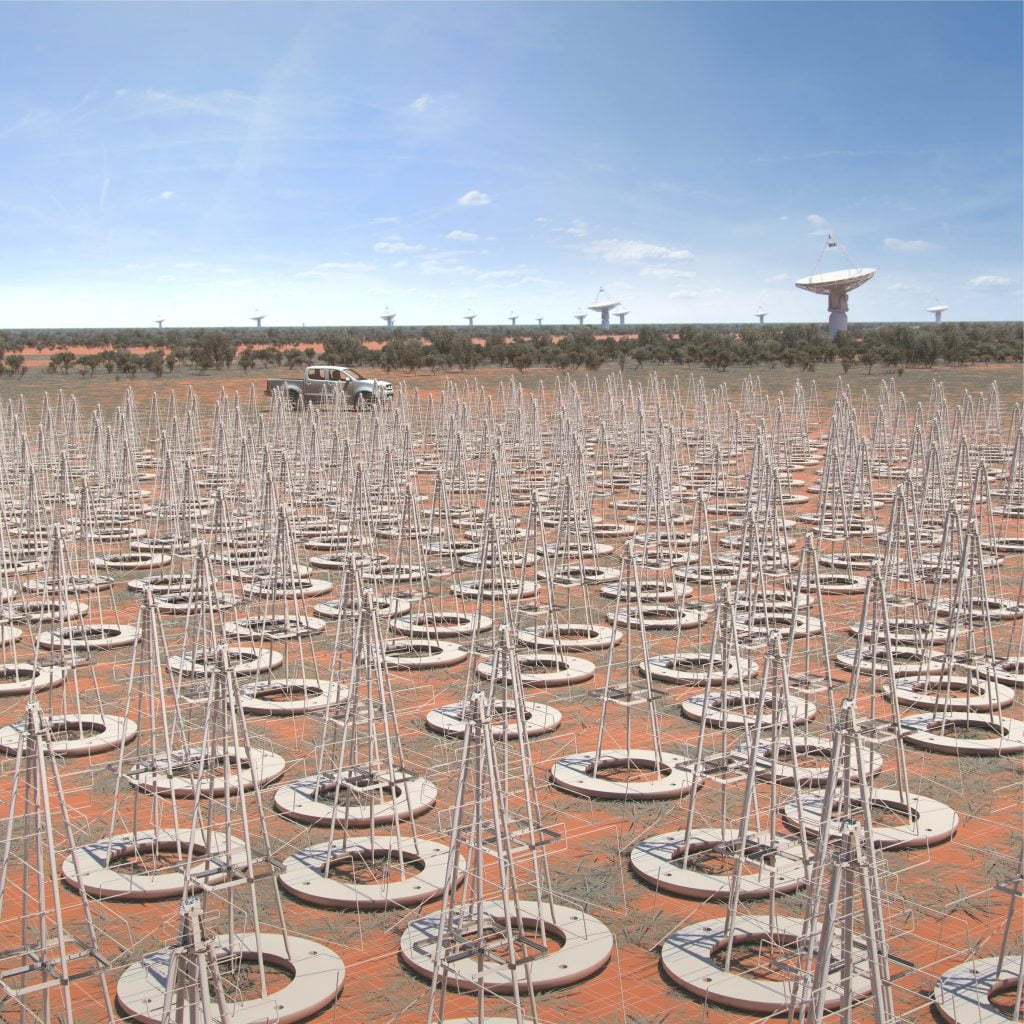
Close up artist rendition of SKA-low. These dipole antenna which will number in their hundreds of thousands will survey the radio sky in frequencies as low at 50MHz.
Dr. Bo Wang of Tsinghua University explains “Our system employs a frequency dissemination and synchronisation method that features phase-noise compensation performed at the client site. One central transmitting module can thus be linked to multiple client sites, and future expansion to additional receiving sites can be realised without disrupting the structure of the central transmitting station.”
The very accurate timing and synchronisation systems will enable the SKA to contribute to many fields from mapping the distribution of hydrogen in the Universe over time to studying pulsars and detecting gravitational waves on a galactic scale, making it complementary to the LIGO & VIRGO gravitational wave observatories.
“The technologies behind these synchronisation systems are also likely to find applications beyond astronomy. Think about currency trading, which requires extreme accuracy in transactions” added André Van Es.
The synchronisation system designs chosen were developed as part of the SaDT Consortium led by Prof. Keith Grainge of the University of Manchester, UK and which includes institutes from eight countries, including the University of Western Australia and Tsinghua University from Beijing, China. SaDT is responsible for the transmission of SKA data and the provision of timing, across two telescope-wide networks.
MORE INFORMATION
ICRAR
The International Centre for Radio Astronomy Research, or ICRAR, is a joint venture between Curtin University and The University of Western Australia with support and funding from the State Government of Western Australia.
The SKA
The Square Kilometre Array (SKA) project is an international effort to build the world’s largest radio telescope, led by the SKA Organisation based at the Jodrell Bank Observatory near Manchester. The SKA will conduct transformational science to improve our understanding of the Universe and the laws of fundamental physics, monitoring the sky in unprecedented detail and mapping it hundreds of times faster than any current facility.
The SKA is not a single telescope, but a collection of telescopes or instruments, called an array, to be spread over long distances. The SKA is to be constructed in two phases: Phase 1 (called SKA1) in South Africa and Australia; Phase 2 (called SKA2) expanding into other African countries, with the component in Australia also being expanded.
Already supported by 10 member countries – Australia, Canada, China, India, Italy, New Zealand, South Africa, Sweden, The Netherlands and the United Kingdom – the SKA Organisation has brought together some of the world’s finest scientists, engineers and policy makers and more than 100 companies and research institutions across 20 countries in the design and development of the telescope. Construction of the SKA is set to start in 2019, with early science observations in the early 2020s.
Read more about the SKA: www.skatelescope.org/
CONTACT INFORMATION
Dr Sascha Schediwy (ICRAR and UWA)
Ph: +61 432 973 133 E: Sascha.Schediwy@icrar.org
Dr David Gozzard (ICRAR and UWA)
Ph: +61 424 482 180 E: David.Gozzard@icrar.org
Pete Wheeler (Media Contact, ICRAR)
Ph: +61 423 982 018 E: Pete.Wheeler@icrar.org
MORE MULTIMEDIA
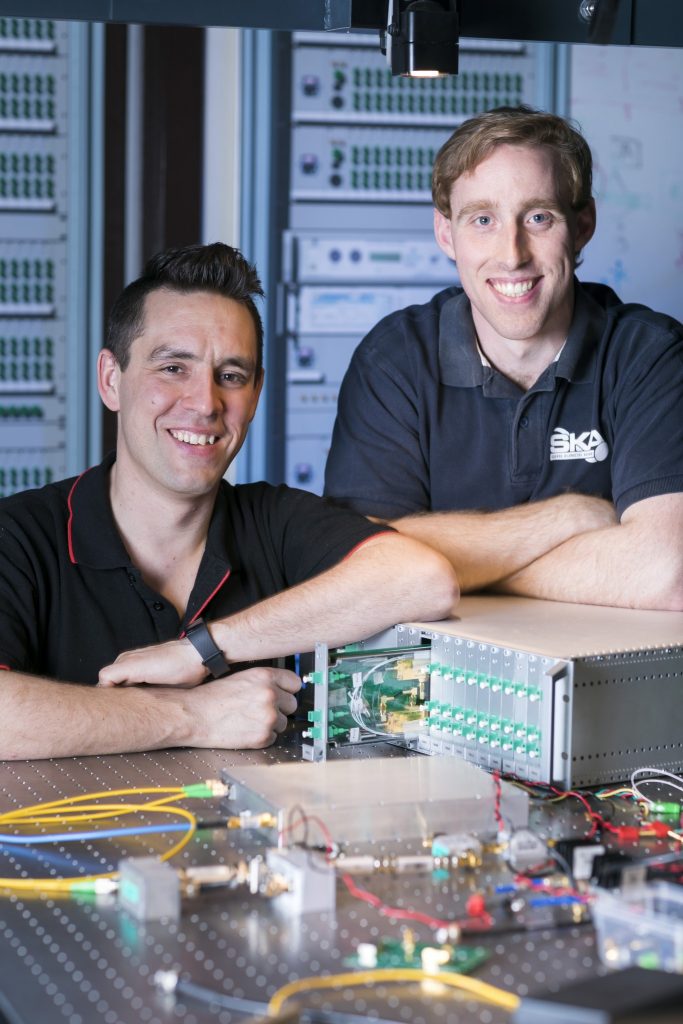
Sascha Schediwy and David Gozzard with a prototype of their SKA-mid Transmitter Module and Sub-Rack enclosure. Credit: ICRAR.
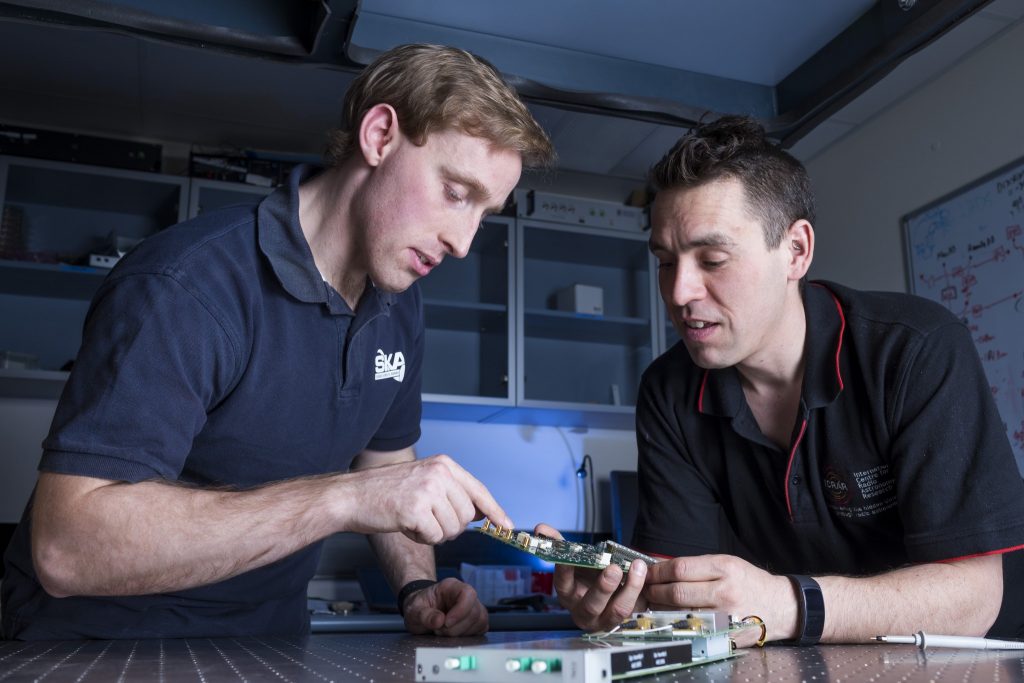
Sascha Schediwy and David Gozzard with components of their SKA-mid phase synchronisation system Transmitter Module. Credit: ICRAR.
